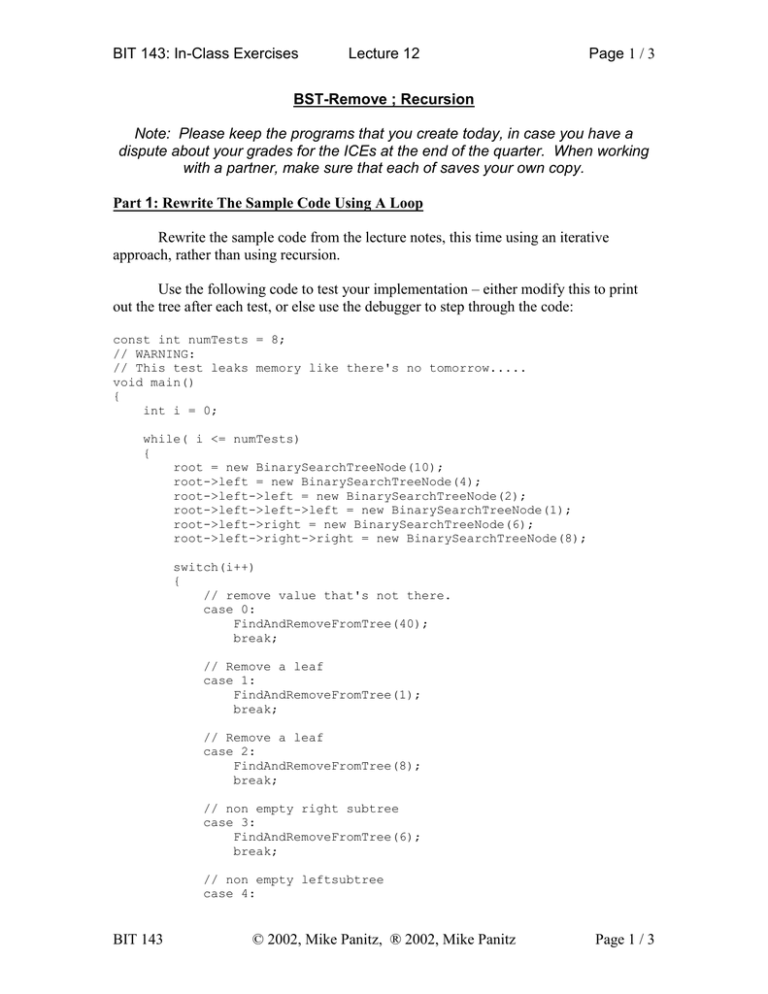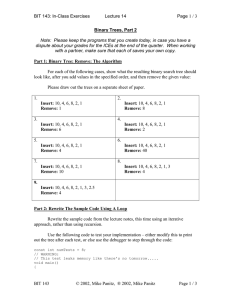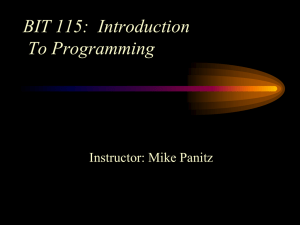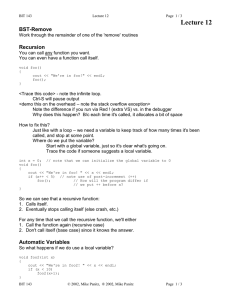ICE: Recursion
advertisement

BIT 143: In-Class Exercises
Lecture 12
Page 1 / 3
BST-Remove ; Recursion
Note: Please keep the programs that you create today, in case you have a
dispute about your grades for the ICEs at the end of the quarter. When working
with a partner, make sure that each of saves your own copy.
Part 1: Rewrite The Sample Code Using A Loop
Rewrite the sample code from the lecture notes, this time using an iterative
approach, rather than using recursion.
Use the following code to test your implementation – either modify this to print
out the tree after each test, or else use the debugger to step through the code:
const int numTests = 8;
// WARNING:
// This test leaks memory like there's no tomorrow.....
void main()
{
int i = 0;
while( i <= numTests)
{
root = new BinarySearchTreeNode(10);
root->left = new BinarySearchTreeNode(4);
root->left->left = new BinarySearchTreeNode(2);
root->left->left->left = new BinarySearchTreeNode(1);
root->left->right = new BinarySearchTreeNode(6);
root->left->right->right = new BinarySearchTreeNode(8);
switch(i++)
{
// remove value that's not there.
case 0:
FindAndRemoveFromTree(40);
break;
// Remove a leaf
case 1:
FindAndRemoveFromTree(1);
break;
// Remove a leaf
case 2:
FindAndRemoveFromTree(8);
break;
// non empty right subtree
case 3:
FindAndRemoveFromTree(6);
break;
// non empty leftsubtree
case 4:
BIT 143
© 2002, Mike Panitz, ® 2002, Mike Panitz
Page 1 / 3
BIT 143: In-Class Exercises
Lecture 12
Page 2 / 3
FindAndRemoveFromTree(2);
break;
// non empty subtrees
case 5:
FindAndRemoveFromTree(4);
break;
// remove the root
case 6:
FindAndRemoveFromTree(10);
break;
// non empty subtrees, use that loop
case 7:
root->left->left->right = new BinarySearchTreeNode(3);
FindAndRemoveFromTree(4);
break;
// non empty subtrees, pred w/ left subtree
case 8:
root->left->left->right = new BinarySearchTreeNode(3);
root->left->left->right->left = new
BinarySearchTreeNode(2.5);
FindAndRemoveFromTree(4);
break;
}
}
}
Part 2: Basic Recursive Function
Create a function which has no parameters, and a global variable (an int) which
you should initialize to a positive number. The function should print out the value of the
global variable, and then decrement the variable by one, and then call itself. Make sure
to include code for the base case (when the argument is less than or equal to zero).
Try removing the base case & see what the program does.
Part 3: Recursive Function With An Argument
Create a function which has a single, integer parameter. The function should
print out the value of it's argument, and then decrement the value by one, and then call
itself. Make sure to include code for the base case (when the argument is less than or
equal to zero).
I'd advise that you make sure that you can trace the code (and even re-copy your
function each time, if that helps)
The above function will print out the numbers from N (where N is a positive
integer) down to 0. How can you modify the above function to print out numbers from 0
up to N, recursively?
BIT 143
© 2002, Mike Panitz, ® 2002, Mike Panitz
Page 2 / 3
BIT 143: In-Class Exercises
Lecture 12
Page 3 / 3
Part 4: What Does This Code Print?
void main(void)
{
cout << "End result: " << foo(5) << endl;
}
int foo(int f)
{
cout << "Handed " << f << endl;
if (f <= 0)
return f;
int i = foo(f – 3);
int j = foo(f – 2);
int max = (i > j?i:j);
cout << "Given " << i << " and " << j;
cout << ", keeping " << max << endl;
return max;
}
Part 5: Computing a value recursively
Create a recursive function which will compute Factorial(N). Factorial is defined
as :
Factorial(n) = n * Factorial(n-1)
Factorial(0) = 1
Your function should have a single parameter, N, and return the Factorial of N.
Part 6: Recursively Print A Linked List
During a previous class, you created a linked list, and learned how to insert an
element at an arbitrary location within the list. You've also seen how to traverse the
entire list, and print each element using a loop.
For this ICE, create a linked list, where each nodes contains an int. You should
be able to reuse the code you wrote in prior classes.
Next, create a recursive print function, which will print out all the ints stored in
the list. Can you change your function so that it prints the list backwards? What about
forwards? Once you've figured out how to print either way, add a bool parameter so that
the caller has the choice of printing the list, forwards or backwards.
BIT 143
© 2002, Mike Panitz, ® 2002, Mike Panitz
Page 3 / 3





